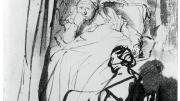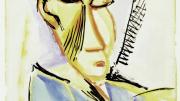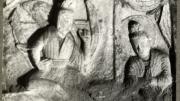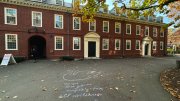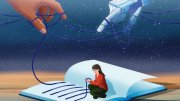In 1966, as a visiting medical student at a London teaching hospital, I interviewed a husband and wife, in their early twenties, who had recently experienced a truly calamitous health catastrophe. On their wedding night, in their first experience of sexual intercourse, a malformed blood vessel in the husband’s brain burst, leaving him with a disabling paralysis of the right side of his body. Stunned and guilt-ridden, the couple clutched hands and cried silently as they shared their suffering with me. My job was to get the neurological examination right and diagnose where the rupture had taken place. I remember the famous professor, who went over my findings, repeating the neurological examination and putting me through my paces as a budding diagnostician. He never once alluded to the personal tragedy for the sad lovers and the shock to their parents. Finally, I found the courage to tell him that I thought the failure to address what really mattered to them—how to live their lives together from here on—was unacceptable. Surely, it was our medical responsibility to offer them some kind of caregiving and hope for the future. He smiled at me in a surprised and patronizing way; then he said I was right to insist that there was more to this case than the neurological findings. The professor had the patient and his wife brought to the lecture hall where he presided over the teaching rounds, and he gave them as sensitive an interview as I might have hoped for, including empathic suggestions for rehabilitation, family counseling, and social-work assistance.
I have long regarded this experience as iconic of contemporary medicine’s caregiving paradox. The balance between science/technology and art has shifted so far toward the former that the latter is a pale shadow, a fragile remnant of what had for centuries been crucial to the work of the doctor. To prepare for a career of caregiving, medical students and young doctors clearly require something besides scientific and technological training that, even as it enables the physician as a technical expert, risks disabling her or him as a caregiver.
That work can be reasserted when we have the time and desire to do so, as the distinguished neurologist showed me, but it is regularly overlooked and left aside. I recently visited a noted southeast Asian hospital where the doctor-patient relationship for patients returning for follow-up visits lasts one to three minutes--hardly time to ask a few questions, do the quickest physical examination, and write a prescription. Not a place where the art of caregiving is likely to flourish. The residents with whom I spoke got the message. The structure of training and of service delivery discourages and even disables the art.
My own experience of being the primary caregiver for my wife, on account of her neurodegenerative disorder, convinces me yet further that caregiving has much less to do with doctoring than the general public realizes or than medical educators are willing to acknowledge. Caregiving is about skilled nursing, competent social work, rehabilitation efforts of physical and occupational therapists, and the hard physical work of home healthcare aides. Yet, for all the efforts of the helping professions, caregiving is for the most part the preserve of families and intimate friends, and of the afflicted person herself or himself. We struggle with family and close friends to undertake the material acts that sustain us, find practical assistance with the activities of daily living, financial aid, legal and religious advice, emotional support, meaning-making and remaking, and moral solidarity. About these caregiving activities, we know surprisingly little, other than that they come to define the quality of living for millions of sufferers.
I lead her across the living room, holding her hand behind my back, so that I can navigate the two of us between chairs, sofas, end tables, over Persian rugs, through the passageway and into the kitchen. I help her find and carefully place herself in a chair, one of four at the oval-shaped oak table. She turns the wrong way, forcing the chair outward; I push her legs around and in, under the table’s edge. The sun streams through the bank of windows. The brightness of the light and its warmth, on a freezing winter’s day, make her smile. She turns toward me. The uneven pupils in Joan Kleinman’s green-brown eyes look above and beyond my head, searching for my face. Gently I turn her head towards me. I grin as she raises her eyebrows in recognition, shakes her long brown hair, and the soft warmth of her sudden happiness lights up her still strikingly beautiful face. “Wonderful!” she whispers. “I’m a Palo Alto, a California, girl. I like it warm.”
I place a fork in her right hand and guide it to the poached egg in the deep bowl. I have already cut up the toast, so that I can help her spear pieces of bread and soak up the yolk. She can’t find the teacup in front of her, so I move her hand next to its handle. The Darjeeling tea glows hot and golden red in the Chinese cup. “Wonderful!” she again whispers.
Later, while I am trying to decide what she should wear, Joan frowns, fussing with her feet. “These nails are too long. And where are my shoes? I need to find my shoes!” She stands before about 18 pairs on a rack, shoes her unseeing brain can’t recognize. “Don’t get agitated,” I interject with foreboding. “Do you want a Zyprexa?”
“No! No pills. Why do I need pills? I’m healthy.”
“Joan, you have Alzheimer’s disease. You’re not healthy. You have a brain disease. A serious problem.” I can barely conceal the frustration in my voice.
“Why did God do this to me? I’ve always been good. I never did anything to cause this. Should I kill myself?” She says it in such a way as to signal to me, as she has before, that this is a statement of pain and a cry for help, not an earnest question to discuss or to make plans. In fact it means the opposite: because, as in the past, she quickly changes tone. “If you love then you can do it! We can live and love.”
“We can do it,” I repeat, each time a little bit more weakly, enduring the unendurable.
And so another morning begins, another day of caregiving and care-receiving between a 69-year-old man and a 70-year-old woman who have lived together passionately and collaboratively for 45 years, absorbed in an intense relationship--intellectual, aesthetic, sexual, emotional, moral. What has made it possible to get even this far are our two adult children, their spouses, my 96-year-old mother, my brother, and our four grandchildren who sometimes take the hand of their often uncomprehending grandmother, because she is standing alone, lost, and lead her back into the protective, enabling circle of our family.
For seven years we have lived through the progressive neurodegenerative disorder that has unspooled the neural networks of Joan’s brain. It originated in the occipital lobes at the far back of the brain. The pathology of undoing has inexorably worked its way forward to the parietal and temporal lobes on the sides of the brain, and finally to the frontal lobes that mount up behind the forehead, through the layers of neurons and nodes of connecting neural nets that structure and retain memories, focus attention, balance emotion with common sense, underwrite judgment, and make possible the ordinariness of reading, writing, telling stories, understanding jokes, recognizing people, orienting oneself in space and in time, but also within emotional and moral coordinates, and, of course, doing things in the world.
This trail of unraveled brain structure and mounting dysfunction is, in physical terms, only one of inches; yet its silent, implacable wrecking creates entirely new conditions for living a life and being with others. Joan has an atypical form of Alz-heimer’s disease. She is functionally blind. She cannot find her way in our home, where she has lived since 1982. She often misinterprets those objects she does see, treating a chair as if it were a table or the floor lamp a person. Left unaccompanied, she walks into doors and has banged her legs so hard into low tables she didn’t see that she has caused deep contusions. Once, at our son’s house, she opened a door and fell down a flight of unseen stairs, breaking her pelvis; at the onset of the disease, she ran into the street, where a pick-up truck ran over her right foot.
Joan can’t, on her own, find her way out of the bedroom. Yet, once safely in my hands or those of our trusted home health aide, she can walk effectively. A China scholar who translated and interpreted ancient texts, she can no longer read. A wife and mother whose fierce commitment to the family was its moral backbone, she now struggles to be part of family functions and can sometimes seem impassive and cut off from us. Formerly the primary caregiver for her husband and children, she is now the care-receiver. She may no longer be who she was even seven years ago, but her subjectivity has not so much disappeared--there is much of her personality that is still present--as altered. And that alteration has affected what had been for four decades an all-consuming relationship--our identity and orientation. I still cannot accept to treat her as if she can no longer share the sensibility and narrative we have created, and yet, more and more frequently, she can’t. She is happy much of the time. It is I, the caregiver, who, more often, am sad and despairing.
She is a source of great concern to each of us, her family members, about how to best manage her condition. We grieve what we have lost and fear what we know lies ahead. We have each of us gone through feelings of loss, anger, and frustration. We have been marked by a special kind of pain. But we have also experienced a deepening sense of responsibility, gratitude for all that we had lived through together, love, solidarity, and a shared sensibility that we have resisted what is beyond our control and are, individually and collectively, more for it. This is not meant as a self-satisfying summing up--there is no final summary yet and the proper genre is tragedy, as millions who are engaged in these everyday practices know.
Economists configure caregiving as “burden.” Psychologists talk about “coping,” health-services researchers describe social resources and healthcare costs, and physicians conceive it as a clinical skill. Each of these perspectives represents part of the picture. For the medical humanities and interpretive social sciences, caregiving is a foundational component of moral experience. By this I mean that we envision caregiving as an existential quality of what it is to be a human being. We give care as part of the flow of everyday lived values and emotions that make up moral experience. Here collective values and social emotions are as influential as individual ones. Within these local moral worlds--family, network, institution, community--caregiving is one of those things that really matters, but usually not the only thing.
As a scholar, I engage with other medical humanists to understand the dimensions of this moral activity--how it is experienced and organized. In part, I hope it can be better taught.I believe that what doctors need to be helped to master is the art of acknowledging and affirming the patient as a suffering human being; imagining alternative contexts and practices for responding to calamity; and conversing with and supporting patients in desperate situations where the emphasis is on what really matters to the patient and his or her intimates. A program of medical training that makes this happen, however it is innovated, should combine practical experience of caregiving for health catastrophes in homes and institutions, where students actually do those things that families do, with the knowledge that stands behind the art of medicine.
But here,I am writing principally about people like me who give care to loved ones who suffer the infirmities of advanced age, serious disabilities, terminal illnesses, and the devastating consequences of such health catastrophes as stroke or dementia.
Faced with these crises, family and close friends become responsible for assistance with all the mundane, material activities of daily living: dressing, feeding, bathing, toileting, ambulating, communicating, and interfacing with the healthcare system. Caregivers protect the vulnerable and dependent. To use the experience-distorting technical language: they offer cognitive, behavioral, and emotional support. And because caregiving is so tiring, and emotionally draining, effective caregiving requires that caregivers themselves receive practical and emotional support.
But, to use the close experiential language of actually doing it, caregiving is also a defining moral practice. It is a practice of empathic imagination, responsibility, witnessing, and solidarity with those in great need. It is a moral practice that makes caregivers, and at times even the care-receivers, more present and thereby fully human.
If the ancient Chinese perception is right that we are not born fully human, but only become so as we cultivate ourselves and our relations with others--and that we must do so in a threatening world where things often go terribly wrong and where what we are able to control is very limited--then caregiving is one of those relationships and practices of self-cultivation that make us, even as we experience our limits and failures, more human. It completes (not absolutely, but as a kind of burnishing of what we really are--warts and all) our humanity. And if that Chinese perspective is also right (as I believe it is), when it claims that by building our humanity, we humanize the world, then our own ethical cultivation at the very least fosters that of others and holds the potential, through those relationships, of deepening meaning, beauty, and goodness in our experience of the world.
I am not a naive moralist. I’ve had far too much experience of the demands, tensions, and downright failures of caregiving to fall into sentimentality and utopianism. Caregiving is not easy. It consumes time, energy, and financial resources. It sucks out strength and determination. It turns simple ideas of efficacy and hope into big question marks. It can amplify anguish and desperation. It can divide the self. It can bring out family conflicts. It can separate those who care from those who can’t or won’t handle it. It is very difficult. It is also far more complex, uncertain, and unbounded than professional medical and nursing models suggest. I know about the moral core of caregiving not nearly so much from my professional life as a psychiatrist and medical anthropologist, nor principally from the research literature and my own studies, but primarily because of my new life of practice as a primary caregiver.
I learned to be a caregiver by doing it, because I had to do it; it was there to do. I think this is how most people learn to be caregivers, for people who are elderly, disabled, or chronically or terminally ill. But of course this is also how parents, especially mothers, learn to care for children. My point is not so dissimilar to what William James claimed was how we learn to feel emotions: we move, we respond, we act. Our muscles (voluntary and involuntary) move. And so out of practices comes affect. And out of practices comes caregiving. And out of the billions of ordinary acts of caregiving perhaps also comes much of that which, imperceptibly and relentlessly, sustains the world.
We are caregivers because we practice caregiving. It is all the little concrete things I described in caring for my wife that taken together and over time constitute my caregiving, that make me a caregiver. So much depends on those concrete things: the doing, the feeling, the shadings, the symphonic complexity, the inadequacy, the living at every moment and over what can be such a long journey of the incompleteness yet the presence of a caregiver.

